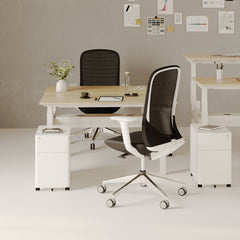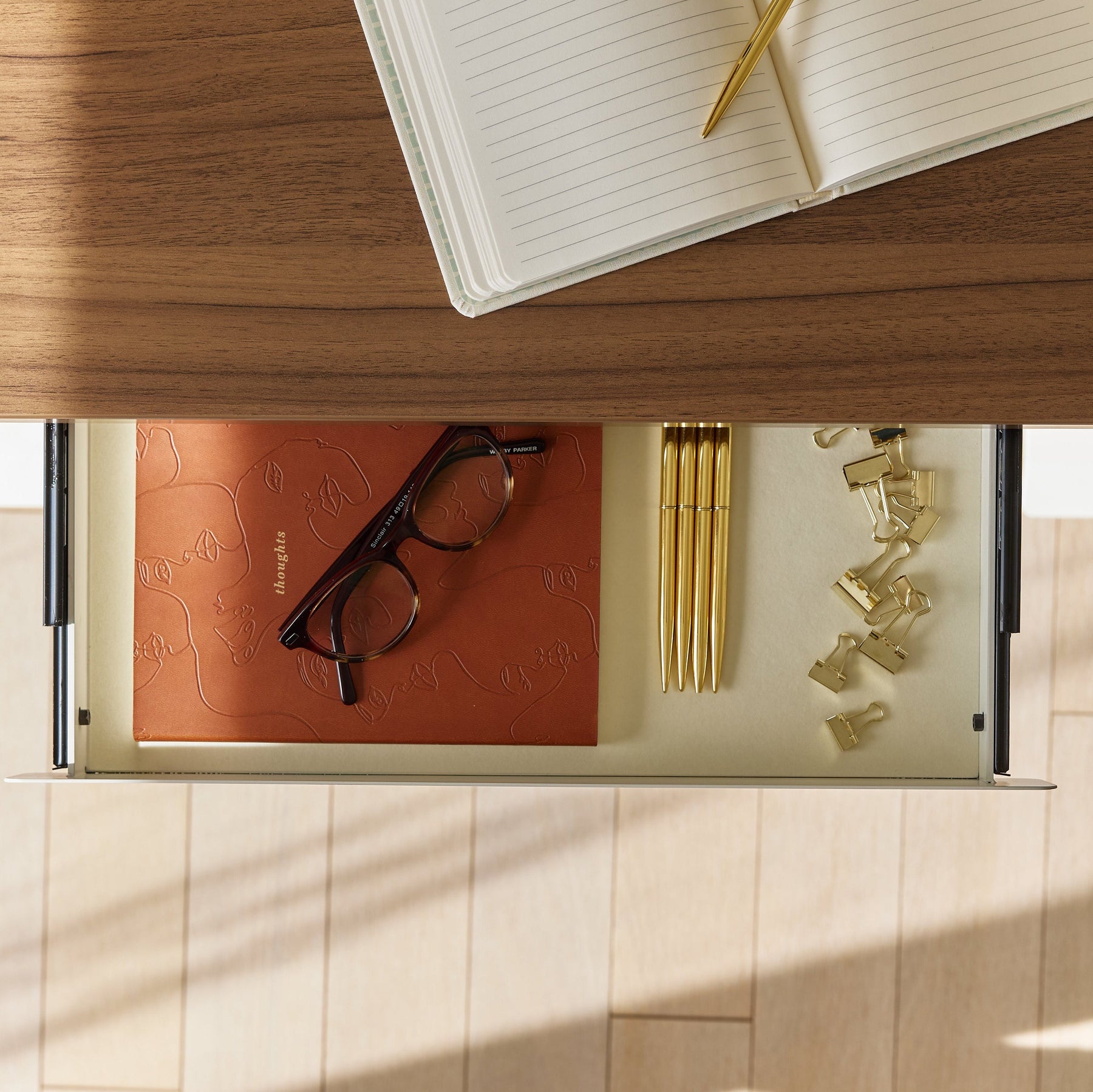Get 10% off your first order
Find the office furniture that’s designed to match your style, comfort, and needs perfectly. Subscribe
Working Together, From Home: Designing a Space That Connects

Visit quiz page to see how we makes it easy to create an inspiring workplace

Modern work is no longer tied to one setting. Some people log in from bustling corporate offices, while others work from home or shared coworking spaces. In all cases, the desk becomes the silent backbone of productivity. An office desk that combines form and function goes beyond a surface to hold your laptop—it shapes how you think, feel, and interact throughout the day.
Every small element of desk design matters. A desk with smart cable routing means fewer tangled wires catching your chair wheels. A surface that allows space for dual monitors without feeling cramped prevents constant rearranging. These subtle details reduce “micro-frictions” that can chip away at focus over time.
Hybrid workers face a unique challenge: switching contexts quickly. A minimalist desk designed with intentional dimensions supports multi-device setups while keeping the visual field calm. That balance between form and function isn’t just nice—it’s essential.
The desk also communicates brand values. A clean, modern design reflects clarity and professionalism to visiting clients or even to yourself when you turn on your camera. It signals discipline and organization, which builds confidence in the work environment.
Ergonomics sit at the heart of function. Neutral wrist angles, relaxed shoulders, and eye-level monitors reduce the risk of repetitive strain injuries. Long-term, desks that integrate ergonomic features can mean fewer aches and more sustained focus. According to evidence-based ergonomic practices for desk work, posture-conscious design has a measurable impact on well-being.
Adjust chair so elbows rest at 90 degrees.
Raise monitor so eyes meet the top third of the screen.
Keep keyboard close enough to avoid reaching.
Place lighting at a 45° angle to reduce glare.
Use a cable tray to keep foot space clear.
For readers seeking inspiration, Urbanica offers minimalist desks that balance beauty and utility tailored for contemporary offices.

Minimalism is more than a style—it’s a method of stripping away excess while amplifying what matters.
Minimalist desks thrive on proportion and restraint. Rather than showing every function on the surface, the complexity is hidden. Power outlets, cables, and even small storage compartments can be concealed beneath the desk to preserve visual calm.
Minimalism doesn’t mean blandness. A walnut desktop or powder-coated steel leg introduces both texture and durability. Materials should be chosen not just for how they look, but how they wear over time.
Clutter distracts. Studies on cognitive load show that clear surfaces reduce decision fatigue. A desk that supports hidden storage solutions helps users maintain visual simplicity, reducing stress while boosting focus.
Low-gloss laminates prevent glare from lighting and fingerprints. Warm woods foster coziness, while cooler metals and whites convey precision and clarity.
Built-in channels, leg routing systems, and grommets make sure technology doesn’t dominate the aesthetic. Hidden cable design keeps the desk sleek and uninterrupted.
The foundation of ergonomics lies in neutral posture. Elbows should rest at 90 degrees, wrists should remain straight, and eyes should level with the top third of the monitor.
Standing desks expand the body’s movement options. Alternating between sitting and standing reduces fatigue, improves circulation, and boosts energy. OSHA guidance on healthy desk postures reinforces that flexibility in workstation design reduces the risk of musculoskeletal disorders.
| User Height | Seated Desk Height Range | Standing Desk Height Range | Monitor Height from Desk | Keyboard Distance | Footrest Needed |
|---|---|---|---|---|---|
| 5’2” | 25–26” | 36–37” | 18–19” | 2–3” | Yes |
| 5’8” | 27–28” | 39–40” | 20–21” | 2–3” | Optional |
| 6’2” | 29–30” | 43–44” | 22–23” | 2–3” | No |
The healthiest workers often adopt the 20–8–2 rhythm: 20 minutes sitting, 8 minutes standing, 2 minutes moving. Desks designed for seamless transition make this rhythm effortless.

Magnetic channels, adhesive clips, and under-desk trays create order without clutter.
Minimalist designs integrate shallow drawers or floating pedestals that keep essentials handy without sacrificing legroom.
Rails and clamp-based systems allow accessories to grow with changing needs, extending the desk’s lifespan.
Surfaces should resist scratches, stains, and heat. A truly functional desk is one that looks new after years of use.
Monitor arms
Flush wireless chargers
Slender task lighting
Hidden compartments for peripherals
| Material | Aesthetic Qualities | Durability | Maintenance | Sustainability Notes | Price Tier | Best Use Cases |
|---|---|---|---|---|---|---|
| Solid Wood | Warm, timeless | High | Moderate | FSC-certified | $$$ | Premium offices |
| Bamboo | Light, eco-friendly | Medium | Easy | Renewable | $$ | Modern home office |
| Steel | Sleek, industrial | Very High | Easy | Recyclable | $$ | Heavy-duty work |
| Laminate | Versatile finishes | High | Easy | Varies | $ | Everyday workstations |
| Glass | Modern, reflective | Medium | High | Recyclable | $$ | Creative studios |
Eco-conscious finishes and sustainably sourced wood prove that style doesn’t need to come at an environmental cost.
Wood: Oil every 6–12 months.
Bamboo: Wipe with damp cloth, avoid standing water.
Metal: Use microfiber, avoid abrasives.
Laminate: Mild soap only, no strong solvents.
Perfect for small spaces, these compact desks prioritize form while still accommodating essentials.
The ability to switch between sitting and standing supports healthier routines. Consider a space-saving standing desk for small offices to bring flexibility into compact environments.
Shared offices benefit from balanced two-person standing workstations, designed for equitable space and ergonomic balance.
Ideal for maximizing small footprints while still providing expansive surfaces.
A minimalistic solution for tiny apartments, these designs save floor space and emphasize simplicity.
| Desk Type | Space Size | Device Load | Collaboration | Best Function |
|---|---|---|---|---|
| Writing Desk | Small | 1–2 devices | Low | Solo, focused work |
| Standing Desk | Medium | 2–3 devices | Medium | Flexible routines |
| Two-Person Desk | Large | 4+ devices | High | Shared offices |
| Corner Desk | Medium | 3–4 devices | Medium | Multi-tasking |
| Floating Desk | Small | 1 device | Low | Compact spaces |
Mock-ups using painter’s tape or AR apps can reveal how a desk fits before purchase.
Take stock of monitors, docking stations, and accessories to ensure adequate desk space.
| Budget | Expected Features | Best Materials | Where to Splurge |
|---|---|---|---|
| Under $300 | Basic storage, laminate | Laminate | Chair & lighting |
| $500–$800 | Height adjustability | Bamboo, veneer | Surface quality |
| $1,000+ | Premium ergonomics | Solid wood, steel | Longevity |
USB-C hubs, modular rails, and replaceable surfaces keep a desk relevant for years.
Room size and desk footprint.
Number of devices.
Cable routing needs.
Ergonomic requirements.
Preferred materials.
Accessory compatibility.
Delivery and assembly path.
A streamlined office desk with everyday storage works well with floating shelves and discreet cable trays.
Load-bearing steel legs, cable grids, and VESA monitor arms keep setups ergonomic and flexible.
Dual-user stations with integrated privacy screens promote collaboration while maintaining visual calm.
Combine overhead ambient light with directional task lamps to reduce glare.
Introduce greenery and natural textures without overwhelming the workspace.
Apply the “one-third empty” rule to keep the desktop visually open.
Wireless charger
Neutral pen tray
Desk plant
Cable sleeve
Slim lamp
Dusting, wiping, and checking fasteners keeps desks sturdy.
| Material | Cleaning Agents | Avoid | Repair |
|---|---|---|---|
| Wood | Oil or polish | Water rings | Sand & refinish |
| Bamboo | Mild soap | Harsh cleaners | Minimal care |
| Steel | Microfiber cloth | Abrasives | Paint touch-up |
| Laminate | Soap & water | Bleach | Replace surface |
Desk stability.
Ergonomic adjustability.
Accessible power options.
Realistic weight ratings.
Surface glare under lighting.
Replaceable parts.
Edge comfort.
Cable tray access.
Low-VOC finishes.
Delivery and assembly clarity.
Avoid desks that look beautiful but block legroom, force poor posture, or complicate cable management.
A 70” minimalist desk streamlined workflow and reduced neck strain.
A sit–stand cadence paired with cable trays kept daily resets quick and stress-free.
Equal space planning and shared power access improved collaboration.
| Desk Type | Minimalism Score | Ergonomic Flexibility | Cable Management | Space Efficiency | Overall Balance |
|---|---|---|---|---|---|
| Writing Desk | 5 | 2 | 2 | 5 | 3.5 |
| Standing Desk | 4 | 5 | 4 | 4 | 4.5 |
| Two-Person | 3 | 4 | 4 | 3 | 3.5 |
| Corner | 4 | 3 | 3 | 5 | 3.75 |
| Floating | 5 | 1 | 2 | 5 | 3 |

Future desks will focus on repairable components and long-term use rather than fast fashion furniture.
Expect antimicrobial finishes, integrated power modules, and wireless charging pads.
Modern minimalist desks prove that form and function can create both warmth and professionalism.
Explore thoughtfully designed minimalist desks that balance beauty and utility to transform your workspace.
Desks that balance aesthetics with usability create a workspace that supports productivity, ergonomics, and visual calm. They enhance comfort, reduce clutter, and align with modern minimalist design principles.
Measure your room, assess your device setup, and consider ergonomic needs. Look for features like adjustable height, durable materials, and discreet cable management.
Yes. Standing desks integrate sleek design with health benefits, offering flexibility to alternate between sitting and standing throughout the workday.
Solid wood, bamboo, steel, and laminate are common choices. Each offers unique advantages in durability, maintenance, and style, allowing you to select based on budget and workspace needs.
Use cable trays, hidden storage, and modular accessories. Keep only essential items on the surface and schedule routine cleaning to maintain both the look and functionality.

Working Together, From Home: Designing a Space That Connects

Simplify to Focus: How Minimalist Furniture Nurtures a Clear Mind

Work With Style: How Your Office Table Reflects Your Personality
Get 10% off your first order
Find the office furniture that’s designed to match your style, comfort, and needs perfectly. Subscribe
Leave a comment